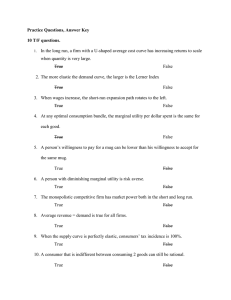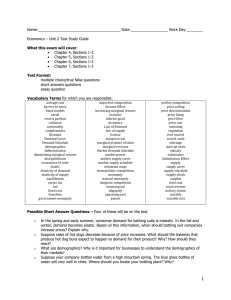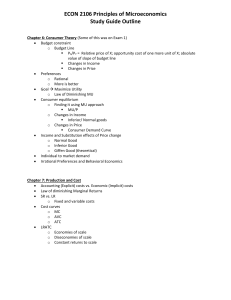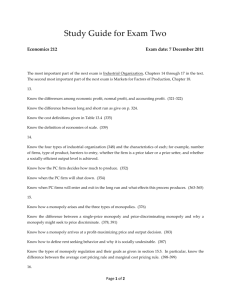econ 201 – microeconomics
advertisement
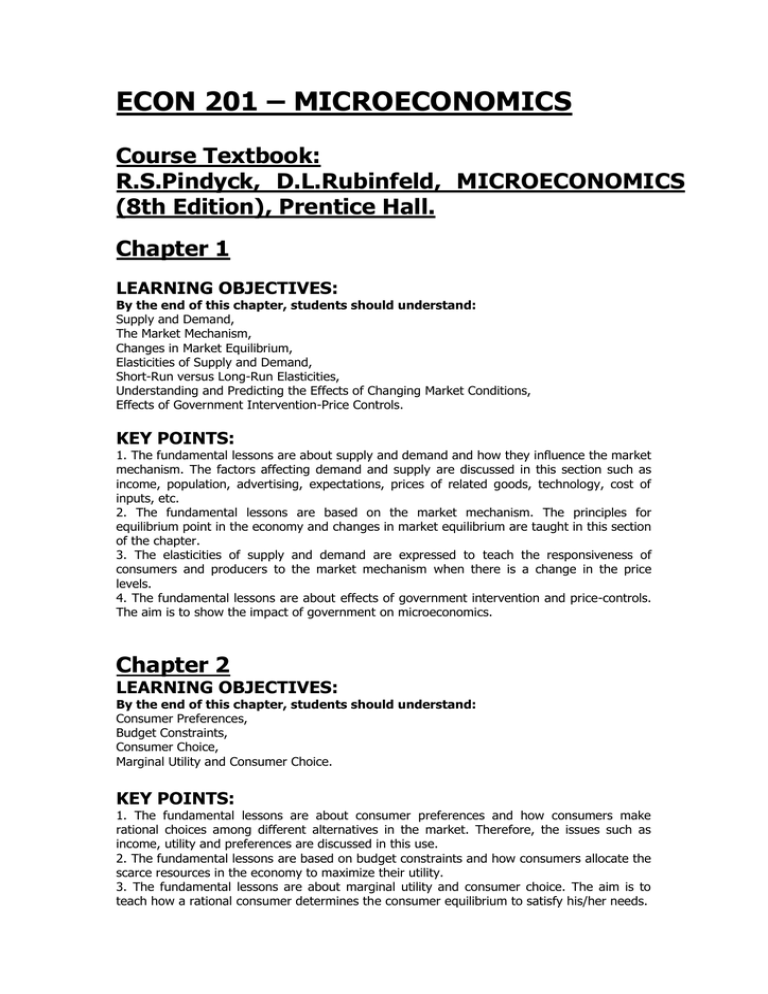
ECON 201 – MICROECONOMICS Course Textbook: R.S.Pindyck, D.L.Rubinfeld, MICROECONOMICS (8th Edition), Prentice Hall. Chapter 1 LEARNING OBJECTIVES: By the end of this chapter, students should understand: Supply and Demand, The Market Mechanism, Changes in Market Equilibrium, Elasticities of Supply and Demand, Short-Run versus Long-Run Elasticities, Understanding and Predicting the Effects of Changing Market Conditions, Effects of Government Intervention-Price Controls. KEY POINTS: 1. The fundamental lessons are about supply and demand and how they influence the market mechanism. The factors affecting demand and supply are discussed in this section such as income, population, advertising, expectations, prices of related goods, technology, cost of inputs, etc. 2. The fundamental lessons are based on the market mechanism. The principles for equilibrium point in the economy and changes in market equilibrium are taught in this section of the chapter. 3. The elasticities of supply and demand are expressed to teach the responsiveness of consumers and producers to the market mechanism when there is a change in the price levels. 4. The fundamental lessons are about effects of government intervention and price-controls. The aim is to show the impact of government on microeconomics. Chapter 2 LEARNING OBJECTIVES: By the end of this chapter, students should understand: Consumer Preferences, Budget Constraints, Consumer Choice, Marginal Utility and Consumer Choice. KEY POINTS: 1. The fundamental lessons are about consumer preferences and how consumers make rational choices among different alternatives in the market. Therefore, the issues such as income, utility and preferences are discussed in this use. 2. The fundamental lessons are based on budget constraints and how consumers allocate the scarce resources in the economy to maximize their utility. 3. The fundamental lessons are about marginal utility and consumer choice. The aim is to teach how a rational consumer determines the consumer equilibrium to satisfy his/her needs. Chapter 3 LEARNING OBJECTIVES: By the end of this chapter, students should understand: Individual Demand, Market Demand, Consumer Surplus Network Externalities KEY POINTS: 1. The fundamental lessons are about individual demand and how an individual demand is derived after determining the consumption for different goods. 2. The fundamental lessons are based on market demand and how this market demand is attained. 3. The fundamental lessons are about consumer surplus because the importance of consumer surplus cannot be neglected. Consumer surplus is the area below the market demand and above the market price. Thus, the existence of consumer surplus affects the decision mechanism of consumers in the economy. 4. The fundamental lessons are about network externalities and how they influence the individual demand and market demand. When a transaction between a buyer and seller directly affects a third party, the effect is called an externality. Negative externalities, such as pollution, cause the socially optimal quantity in a market to be less than the equilibrium quantity. Positive externalities, such as technology spillovers, cause the socially optimal quantity to be greater than the equilibrium quantity. Chapter 4 LEARNING OBJECTIVES: By the end of this chapter, students should understand: Technology of Production, Production with One Variable Input (Labor), Production with Two Variable Inputs and Isoquants Returns to Scale KEY POINTS: 1. The fundamental lessons are about factors of production. The issues based on production are discussed in this part of the chapter. The effects of land, labor, capital and productivity are discussed in this chapter. 2. The fundamental lessons are about one variable input, which is labor. Thus, production in short run is explained with its principles in this chapter. 3. While discussing the productivity, the importance of production with two variable-inputs and isoquants are discussed to teach the principles for an efficient production. 4. Returns to scale is analyzed to demonstrate the essentials for scale production. Chapter 5 LEARNING OBJECTIVES: By the end of this chapter, students should understand: Measuring Cost: Which Costs Matter?, Cost in the Short-Run, Cost in the Long-Run, Long-Run versus Short-Run Cost Curves and Economies of Scale KEY POINTS: 1. When analyzing a firm’s behavior, it is important to include all the opportunity costs of production. For example, the wages a firm pays its workers are explicit. Others, such as the wages the firm owner gives up by working in the firm rather than taking another job, are implicit. 2. Firm’s total costs can be divided between fixed costs and variable costs. Fixed costs are costs that are not determined by the quantity of output produced. Variable costs are costs that directly related to the amount produced and so change when the firm alters the quantity of output produced. 3. Average total cost is total cost divided by the quantity of output. Marginal cost is the amount by which total cost changes if output increases (or decreases) by 1 unit. 4. For a typical firm, marginal cost rises with the quantity of output. Average total cost first falls as output increases and then rises as output increases further. The marginal cost curve always crosses the average total cost curve at the minimum of average total cost. 5. Many costs are fixed in the short run but variable in the long run. As a result, when the firm changes its level of production, average total cost may rise more in the short run than in the long run. Chapter 6 LEARNING OBJECTIVES: By the end of this chapter, students should understand: Perfectly Competitive Markets Profit Maximization Marginal revenue, Marginal Cost and Profit-Max Choosing Output in the SR SR Supply Curve SR Market Supply Choosing Output in the LR The Industry LR Supply Curve (upto p302) KEY POINTS: 1.The fundamental lessons are based on a features of a competitive firm which is a price taker,. Thus, its revenue is proportional to the amount of output it produces in the economy. The price of the good equals both the firm’s average revenue and its marginal revenue. 2. One goal of this type of firms is to maximize profit, which equals total revenue minus total cost. 3. The perfectly competitive firm can maximize maximize profit if it chooses a quantity of output such that marginal revenue equals marginal cost because marginal revenue for a competitive firm equals the market price, the firm chooses quantity so that price equals marginal cost. At that point, the firm’s marginal cost curve is its supply curve. 4. In the short run when a firm cannot recover its fixed costs, the firm will choose to shut down temporarily if the price of the good is less than average variable cost. In the long run when the firm can recover both fixed and variable costs, it will choose to exit if the price is less than average total cost. 5. In a market with free entry and exit, profits are driven to zero in the long run. In this longrun equilibrium, all firms produce at the efficient scale, price equals the minimum of average total cost, and the number of firms adjusts to satisfy the quantity demanded at this price. Chapter 7 LEARNING OBJECTIVES: By the end of this chapter, students should understand: Monopoly Monopoly Power Sources of Monopoly Power Social Cost of Monopoly Power KEY POINTS: 1. The fundamental lessons are about monopoly because monopoly is the exclusive possession or control of the supply of or trade in a commodity or service. 2. In order raise the awareness of the students; the monopoly power is discussed because this firm is the only supplier in the economy. In this respect, its performances are analyzed in this chapter. 3. The sources of monopoly power depend on being a price maker and being a single supplier in the economy with the specified entry barriers. Since there is a unique production in the economy, sometimes there exists social cost of monopoly power.




